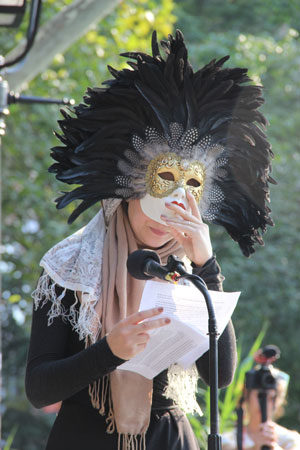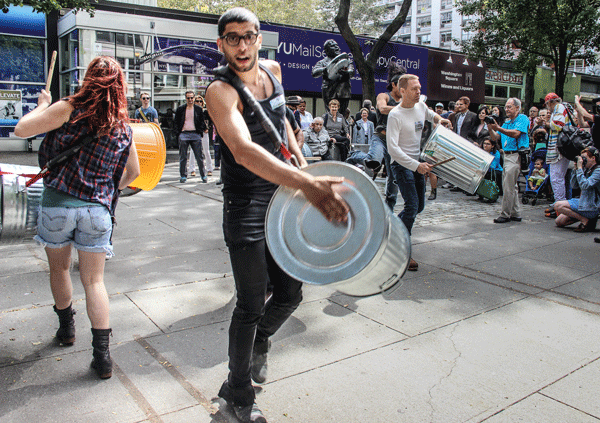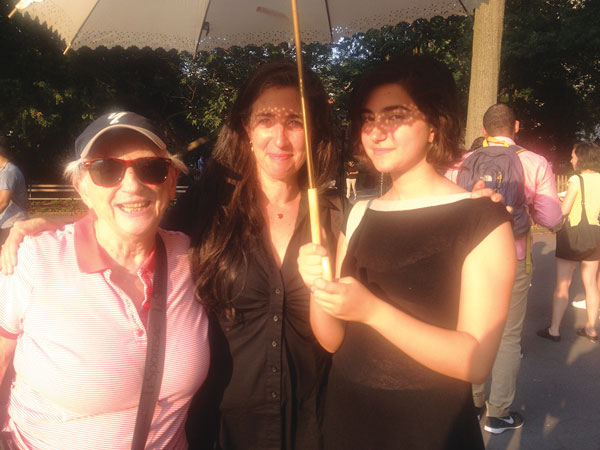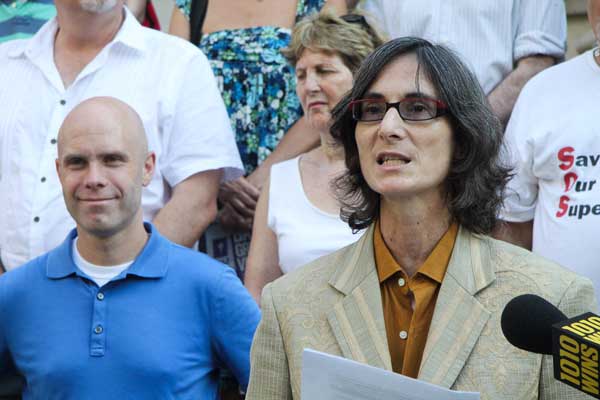
BY LINCOLN ANDERSON | In June, the state’s highest court ruled against a community lawsuit seeking to block N.Y.U.’s massive South Village development plan, clearing the way for the nearly 2-million-square-foot, 20-year project to finally move forward.
But as disheartening as that loss was for the opponents, it hasn’t lessened their will to rail against New York University’s ongoing institutional sprawl in historic Greenwich Village, as well as the school’s sky-high tuition costs and associations with repressive foreign regimes.
About 200 people turned out for a wide-ranging rally — under the catchall banner of “fight the corporate university” — in Washington Square Park on Tuesday.
Assemblymember Deborah Glick was the only elected official at the rally, since many people are now out of town on summer vacation. In her remarks, speaking from the small stage south of the Garibaldi monument, she fired up the crowd.
“We are here to continue the fight,” said Glick, who was a plaintiff in the lawsuit against the N.Y.U. 2031 project. “The fight is not over.”
She said the four-building development project slated for two of the university’s superblocks first “got legs” under the Bloomberg administration, “who said N.Y.U. has raised Villagers’ property values.”
But Glick said the university is the one benefiting from its association with the Village, not vice versa.
“N.Y.U. used its location in this iconic neighborhood to attract its student body — not the other way around,” she stressed, adding, “And upon graduation, their students learn they have a mortgage on their education and they suffer forever with a yoke of debt around their neck.”
The lawsuit delayed the start of the project for three years.
“We have an opportunity to continue dragging it out — by joining hands when the bulldozers come,” the assemblymember declared, to cheers from the crowd.

At every turn, the community is facing overdevelopment, she said, from Gansevoort St., where developers want to raise the building heights on a historic, landmarked low-scale block, to Hudson River Park, where, she said, “an individual wants to build a new-fangled pier,” referring to Barry Diller and the Pier55 “arts island” project.
Similarly, the city is trying to shoehorn residential buildings into Brooklyn Bridge Park, she said.
Concluding her remarks, she told the crowd, “We’ll see you when they come with the bulldozers!” to cheers.

Representatives of N.Y.U. student and faculty groups blasted the school for having, in their view, overpaid administrators and underpaid faculty, which, they charged, is hurting the students’ education. Meanwhile, tuition at the Village school now stands at more than $46,000 a year.
Mark Crispin Miller, the leader of N.Y.U. Faculty Against the Sexton Plan, delivered cutting comments against outgoing president John Sexton. Miller, like many of the school’s faculty, lives in N.Y.U. housing right in the middle of the future construction zone.
Meanwhile, he said of Sexton, “He’s probably on Fire Island in his beach house — built with a million-dollar loan [from N.Y.U.], built across three lots.”
The British-born Andrew Hamilton will be taking over as N.Y.U. president this coming January. Contrasting him with Hamilton, Miller scoffed at Sexton — known for freely giving warm bear hugs and sporting a Yankees cap — for his effusiveness and boosterism.
“I’m sure he’s got a lot more class than John Sexton,” he said of the new university head, “but that should make us uneasy, because he’s hired by the same board as Sexton, with the same program.”
Next, came what was the event’s highlight — or perhaps, some might say, it’s lowlight.
A young woman walked onstage wearing an elaborate, black-feathered mask. It was modeled after the one worn by Mandy, a prostitute in “Eyes Wide Shut,” the 1999 movie starring Tom Cruise and Nicole Kidman about high-end sex parties.

A rising N.Y.U. junior, she said that to afford her tuition she had to turn to working as a dominatrix in an S&M den. After the bruises became too much, she switched to being a body-rub girl in a tantric massage house, where “happy endings” were expected.
She is just one of many young college students, she said, who have had to turn to the likes of craigslist, backpage.com and SeekingArrangement just to make ends meet.
“Before I became a prostitute, I was a top student,” she said, her voice trembling slightly.
As a first-generation college student, she explained, she didn’t want to give up on her education. But as she continued to do sex work, her grades slipped and she found she was always handing in her papers late.
Her sole living parent had expected a settlement from an accident, which was going to help fund her daughter’s education, but it never panned out, and then the mother died.
“I tried to transfer — but no university I applied to, either public or private, would take N.Y.U.’s credits,” she said.
This was because the department she is in at N.Y.U. is a unique, liberal, creative one, a friend later explained.
Most of the other young women she worked with in the dungeon or tantric massage place were, like her, college students.
“Some were Sarah Lawrence girls, some were from CUNY — but the vast majority were from N.Y.U.,” she said. “Masseuse, stripper, escort, prostitute — it is an epidemic. We come to the universities to better our lives. No girl should have to sell herself for a better life.”
Right now, she has enough cash to last the next three months.
“I am lucky. I’m out,” she said. “But I’m afraid if things don’t work out, I might have to go back.”
Finishing her wrenching story, she turned and walked off the stage to sustained applause.
“That took a lot of guts — even with a mask on,” Miller said.
A recent article in the Atlantic reported that N.Y.U. is the first university to “cross the 1,000 sugar babies” threshold” on SeekingArrangement, a site that connects young women with wealthy “sugar daddies.”
Among those at the rally were three women representing three generations of a family from 505 LaGuardia Place, which is located on one of the superblocks where N.Y.U. would build.
Sarah Soffer, who grew up in the building with former Councilmember Alan Gerson and attended Stuyvesant High School with him, said she only wished Gerson had been re-elected to a third term, feeling he would have fought the university’s project forcefully, unlike Margaret Chin.
“I feel that Chin has a large district with a varied constituency and didn’t realize the damage this would do to the community,” she said of N.Y.U. 2031. “I went to all the hearings, and I never heard anyone who wasn’t either in construction or from N.Y.U. speak up for the plan.”
Other councilmembers automatically deferred to Chin, since the project is in her district, she said, whereas if Gerson had been fighting it, it wouldn’t have sailed through. Meanwhile, Community Board 1, in Lower Manhattan, actually was begging N.Y.U. to build down there instead, she recalled.
Her daughter, Eve Liberman, 14, sat next to actor Matthew Broderick in the City Council three years ago when they both took turns testifying against the project. Asked if her thoughts about the N.Y.U. plan have changed since then, she said no.
“No, it hasn’t,” she said. “Back then I was in sixth grade, I was 11. I was traveling out of the neighborhood by subway to school. And if I was doing that, why couldn’t the N.Y.U. students? I’m traveling even farther now to get to school,” she said.
In that vein, her mom added that cramming all of the students into a campus “core” in the Village doesn’t serve them well, either.
“The nature of coming to New York City as a student is to embody the city at large,” she said. “This is New York — either it’s for you or it isn’t. I think many students see N.Y.U. as a place to explore New York.”
Asked for her view, grandma Shirley Soffer — an original tenants of 505 LaGuardia — said, “I don’t agree with the destruction of the community. We need to have the open space.”
District leader candidate Terri Cude summed it all up succinctly: “Flowers not towers; parks not perks.”
“Everyone talks about town-gown conflict,” she said. “We are town and gown together against a real estate developer that shares its name with a university.”
Although none of the opponents’ celebrity supporters were on hand, they did help the cause digitally. Padma Lakshmi, Susan Sarandon, Mark Ruffalo and John Leguizamo all tweeted about the rally, while Matthew Modine — whose number of followers is blowing up with the success of his new series, “Proof” — did a retweet about it.
John Beckman, the university’s spokesperson, countered the charges made at the rally with some statistics.
He said N.Y.U. has increased its financial aid budget by 185 percent since 2002 and provides nearly $270 million annually in scholarships. Since 2010, he said, N.Y.U. has reduced the average debt upon graduation by more than $13,000 — with the average debt for an N.Y.U. graduate below the national average. Also, he noted, N.Y.U. for the past 10 years has continued to be ranked in the top five of the Princeton Review’s “dream schools.” Financially, the university’s endowment has tripled since 2002, and both S&P and Moody’s have rated N.Y.U.’s bonds in the AA range, he noted. Plus, 20 percent of incoming freshmen, he pointed out, are the first in their family ever to attend college.
N.Y.U. is planning to keep Coles gym, on Mercer St., open through at least Nov. 15. The university plans to start the N.Y.U. 2031 project there, by tearing down Coles and replacing it with a far-larger building, currently known only as the “Zipper Building,” which would have a new gym in its basement level. The current gym serves 3,000 people daily during the school year. N.Y.U. says it will meet the needs of its student athletes and swimmers at its Palladium building on E. 14th St. and “through other arrangements at nearby external venues.” N.Y.U. is also readying a new fitness facility at 404 Lafayette St. that will contain cardio training and recreation classes.
Miller protested, “Is there another major university without a proper gym for its entire community? Considering how much it costs to go to N.Y.U., there is no good reason to deprive our students of that indispensable resource.”

















